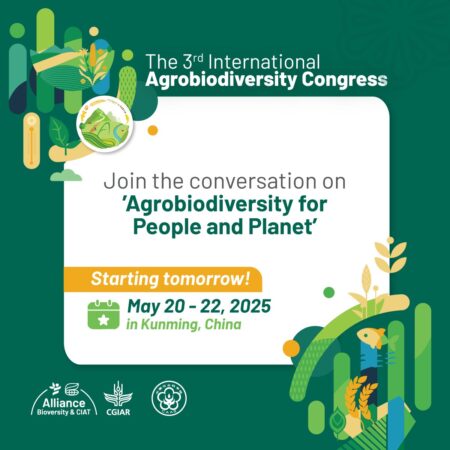Jeremy’s latest newsletter has agrobiodiversity-adjacent snippets on the re-making of an ancient bread in Turkey and on the “oenification of olive oil.” Plus a thing on oysters which is maybe not so adjacent but is also fun and sports a title that is worth the price of admission on its own. Read it.
Brainfood: Balanced diets, Diverse diets, Diverse flavonoids, Micronutrients and GHGE, African traditional diets, Tef diversity, Intercropping, Sleeping crops, Cluster bean, Taste
- A framework for adequate nourishment: balancing nutrient density and food processing levels within the context of culturally and regionally appropriate diets. Some processing, but not too much. Some animal-source food, but not too much.
- Diversity of Plant-Based Food Consumption: A Systematic Scoping Review on Measurement Tools and Associated Health Outcomes. And make the non-animal-source food diverse.
- High diversity of dietary flavonoid intake is associated with a lower risk of all-cause mortality and major chronic diseases. Make the flavonoids diverse too, while you’re at it.
- Greenhouse gas emissions in relation to micronutrient intake and implications of energy intake: a comparative analysis of different modeling approaches. It’s unclear whether diets that deliver more (and more diverse?) micronutrient are worse for greenhouse gas emissions.
- Africa’s contribution to global sustainable and healthy diets: a scoping review. African traditional diets are pretty healthy. I’m betting their greenhouse gas emissions are low and all.
- Population genomics uncovers loci for trait improvement in the indigenous African cereal tef (Eragrostis tef). Which is not to say that traditional African crops could not be improved, healthwise.
- Hidden potential of cluster bean: an unexploited legume crop for food and nutritional security. Or other underused traditional crops, for that matter.
- Impacts of biodiversity-positive intercropping systems on food quality, safety and the consumer acceptance: A case study of intercropped wheat. What, the food needs to be intercropped too? Another tick for African diets.
- The sleeping crops of eastern North America: a new synthesis. Traditional eastern North American crops, production systems and diets probably tick a bunch of boxes too. Awake, Cinderellas!
- But does it taste good? A plea to consider the importance of flavor in managing plant genetic resources. None of the above matters, I suspect, if the stuff doesn’t taste good. I’m looking at you, teff and cluster bean.
Brush up your seedcraft
I recently came across a few interesting resources that I’d like to share.
Bangor University has a publication out that might be useful to people doing research — or perhaps even implementing projects — having to do with in situ conservation: Conservation social science: A handbook for conducting research on rule breaking in conservation. 1
Understanding who follows rules and why, is pivotal for shaping and informing the design of conservation policy and strategies on the ground. If based on erroneous assumptions, sustainable solutions are unlikely to be realised. Conservation scientists need skills and methods that help them understand the prevalence and drivers of illegal activities.
I never really thought about it, but yeah, I guess they do. In any case, always a good idea for biology-focused conservationists to brush up on social science methods.
I’m not sure if the Center for Plant Conservation’s Applied Plant Conservation Course deals with rule-breaking explicitly, but Module V: Common Reasons for Reintroduction/Mitigation Failure might well cover it to some extent.
And finally, Kew has a cryopreservation course in the works for November 2025. And a more general seed conservation techniques course for October. No illegal activities are envisaged.
Nibbles: Indian vault, Sundarban rice, Community seed banks, Fiji cassava, Georgia documentary, Kenya seed network, Nigeria mobilizes, Coffee prizes, Slow Food guardians, Peasant seed sovereignty, World Economic Forum seed pean, Seed sector shindig, Genesys acceleration
- Times of India says “India needs a new doomsday seed vault.” Why not just use the one already there in Svalbard?
- Meanwhile, women in the Sundarban are doing it for themselves.
- Maybe it’s community doomsday seed vaults that India needs?
- Fiji’s cassava is facing a doomsday of its own.
- Georgia — the country — is working on a documentary on crop diversity which will no doubt include their seed deposit in Svalbard.
- Kenya has a pretty good community genebanks video of its own.
- Nigeria is all over crop diversity. Not just once, but twice.
- Coffee prices going up? Can you imagine what will happen if we don’t conserve enough of its diversity?
- Want more examples of the coolness of crop diversity and its guardians? Slow Food has your back.
- La Via Campesina needs to encouragement either, where “peasant seeds” and their guardians are concerned.
- Even the World Economic Forum wants in on the act.
- And yet the seed sector seems…reluctant?
- Good job Genesys is getting faster, eh?
3rd International Agrobiodiversity Congress winds down
I occurs to me that I haven’t mentioned the Third International Agrobiodiversity Congress much since it was originally announced. Sorry about that. Anyway, it’s all over now, and it seems to have been very well attended and reasonably productive. There was supposed to be a “manifesto” coming out but I see no sign of it online yet. I’ll keep you posted. But if you were there, do tell us all who couldn’t be there how it went.
